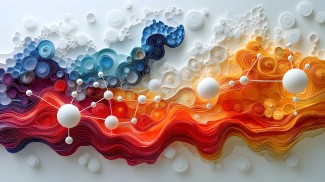Noradrenaline is a neurotransmitter that plays a key role in regulating physiological and behavioral responses, including stress response, alertness, memory, impulsivity and attention. It also regulates our blood pressure and heart rate.
Noradrenaline synthesis: a precise enzymatic process
Noradrenaline production follows a precise biochemical sequence. Tyrosine, a specific amino acid present in the body, is transformed into dopamine, another crucial neurotransmitter, through the action of a key enzyme: tyrosine hydroxylase. Dopamine is then hydroxylated by the enzyme dopamine β- hydroxylase to create noradrenaline.
The life cycle of noradrenaline
Release and interaction with receptors
Once synthesized, noradrenaline is released into the synaptic space during nerve impulse transmission. Noradrenaline’s action is then exerted via adrenergic receptors, which fall into different categories:
- Alpha-1 receptors: located in the post-synaptic region of the sympathetic nervous system, they are involved in vasoconstriction and increasing blood pressure.
- Alpha-2 receptors: located in the pre-synaptic region of the sympathetic nervous system and in the post-synaptic region of the brain. They play a role in regulating the release of other neurotransmitters.
- Beta-1 receptors: mainly located in the heart, these receptors are involved in increasing heart rate and increasing the force of cardiac contraction.
- Beta-2 receptors: found in various sympathetically innervated structures, involved in bronchodilation and the relaxation of smooth muscles.
Degradation and recapture: a regulatory mechanism
Once its action is completed, noradrenaline is either degraded or recaptured for future use. Two main enzymes are involved in its degradation:
• Catechol-O-methyltransferase (COMT): this enzyme directly metabolizes noradrenaline in the synaptic cleft.
• Monoamine oxidase (MAO): this enzyme degrades noradrenaline captured by nerve endings.
Active recapture regulates the quantity of noradrenaline available in the nervous system, avoiding over-stimulation of the receptors.
The role of noradrenaline in the human body
A vital molecule for alertness and stress
Noradrenaline is directly involved in our stress response and how we regulate attention. When someone is in a stressful situation, releasing noradrenaline at an optimal concentration allows a context-appropriate response by mobilizing the body’s resources. For example:
- Increasing the heart rate and blood pressure to prepare the body for action.
- Increasing alertness and concentration to be able to react quickly.
- Mobilizing energy by stimulating the release of glucose by the liver.
Implications for neurological and psychiatric diseases
Noradrenaline is rarely the only neurotransmitter involved in a central nervous system disease.
If the concentration of noradrenaline in the brain is too low, this can impair alertness. By contrast, concentrations that are too high can produce a stress state, which can lead to impulsivity.
Dysfunction in the noradrenergic system can be a factor in several conditions:
- Depression: noradrenaline deficiency is often associated with mood disorders. Certain antidepressants act to increase its availability.
- Attention deficit hyperactivity disorder (ADHD): noradrenaline plays a role in attention and impulsivity. This explains why certain treatments that stimulate noradrenaline activity are effective.
- Parkinson’s disease: a noradrenaline deficiency as a result of neuronal loss in the dark matter can lead to motor disorders in sufferers, but also to depressive syndromes before disease onset.
D'autres mots qui pourraient vous intéresser
- Dopamine :
- Nicknamed the “pleasure molecule”, dopamine is a chemical messenger that allows information to flow between certain types of neuron.
- Serotonin :
- A neurotransmitter involved in mood management and associated with happiness. Often called the “happiness hormone”, serotonin activates or inhibits brain activity depending on the receptor to which it binds. Serotonin is essential for neurons to...

